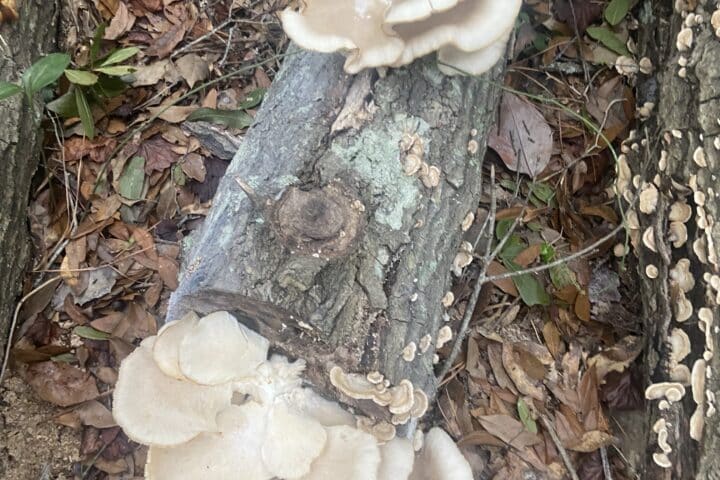There is not a time of year that I don’t enjoy exploring the woods. It rarely fails to deliver me a peaceful mind. However, it is also nice when the woods can ease your anxieties while also providing a tasty treat like a persimmon, paw paw, or mushrooms. Well, a dormant woodland doesn’t necessarily mean a paucity of edible food; I am not talking about eating degraded acorns or turning over logs in search of arthropod larvae. Although you could derive nourishment from them, I would hardly call them a delectable treat. However, while I was unloading my mental burdens during a recent run through the woods, I was delighted to find my favorite mushroom common to eastern forests, the winter oyster mushrooms (Pleurotus ostreatus) growing on an oak log and stump along the trail.
This species of fungus can be found in woodlands throughout North America except the Pacific Northwest where its oyster mushroom relatives, P. pulmonarius and P. populinus, dominate. All oyster mushrooms are saprophytic and aid in the decomposition of dead, organic material (specifically woody tissue), so they are essential in the nutrient cycling in our woods. They are also known to be carnivorous….to nematodes. The fungus’s mycelium can trap and digest these tiny worms to extract much needed nitrogen.
The winter oyster mushroom is easily identifiable. It has broad, fan-shaped caps with deep gills underneath that can vary in color from tan to brown to white. The caps sit on a short, nearly absent stem that is not always evident, and they usually grow in clusters on decaying logs or stumps of decomposing deciduous trees. I have seen them growing on the stumps of conifers, too. The name winter oyster mushroom is kind of a misnomer because the fungus can fruit throughout the year multiple times, particularly after rain when the temperature is cool but mild, like our winter so far. I found these oyster mushrooms two days after a heavy rainstorm when the temperatures were in the upper 40’s and low 50’s.
Although the winter oyster mushroom is easily identifiable, you should never consume any mushroom unless you are 100% certain of the species. There are many resources and mushrooms foraging groups out there that can help you learn more about the mushrooms in our woods.
If you see something blooming, leafing out, ripening, or otherwise changing in your woods, send us photos (forestsforthebay@gmail.com) to include in next month’s Forests for the Bay newsletter for more phenological fun.

